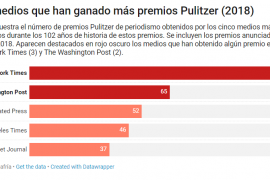
You would never say that Mari Carmen Tous is 85...

Minister for Enterprise and Knowledge Àngels Chacón highlights that “over...

Leticia Beleta, director of Alexion Pharmaceuticals in Spain and Portugal,...
In hospitals, besides managing health, they manage life and death...

There are things that only happen once in a lifetime....

Barcelona has become a desired destination for investors, beyond the...

Every great theory of the mythical German physicist was born...

The New York Times, with a total of 125 awards,...

The direct relationship between intelligence and success applies to any...

Take a deep breath. Alright? We are going to talk...

Música clásica sobre la arena de la playa en dos...

The first session of the cycle on the regatta organized...

The hospital's managing director, Manel del Castillo, and the pharmaceutical...

Generalitat y Ayuntamiento impulsarán dos equipamientos de 'Casa de les...

Leticia Beleta, director of Alexion Pharmaceuticals in Spain and Portugal,...

We all have a friend who never leaves the Gràcia...

Barcelona director opts for Best International Film with 'La sociedad...

The hotel and industrial sectors softened the market's decline last...

The technology company, with a workforce of 35 employees and...

“The women of yesteryear were strong and had to fight...
[dropcap letter=”D”]
ocumentaries not only allow us to show realities that might seem remote at first, but -perhaps even more interestingly- to focus on aspects of our immediate reality that would go unnoticed, or that aren’t emphasized enough, and are therefore not addressed. Many tapes are used to depict exposures, which add a social aspect to the artistic or informative values of documentaries. We can mention a few titles from the most recent past which have transcended and have led to raise awareness. They also have an unequal effect, that is, they don’t always succeed in subverting or completely preventing what is exposed. A documentary that comes to mind is Bowling for Columbine, by Michael Moore, who won an Oscar in 2002. A film that, as a result of the massacre perpetrated in an American high-school, reflects on violence in society, and addresses a thorny issue more specifically: the right to bear arms. Four years later, in 2006, the award would go to An Inconvenient Truth by David Guggenheim, based on Al Gore’s work by the same title, which warns of the fateful consequences of man’s influence on climate change.

Even if not all the praised and celebrated documentaries explicitly expose an issue (like Man on the Wire by James Marsh or Searching for Sugar Man by Malik Bendjelloul, Oscar winners in 2009 and 2012, not to mention the fascinating “fake” documentary Exit Through the Gift Shop by Banksy, finalist in 2010) and taking our society’s increasingly critical conscience into account -like recently with the demand for real equality between genders-, it now seems that focusing on this genre is more important than ever. Similar to what happens in the case of some composers with their chamber music -the most obvious case is surely Shostakovich- documentaries, less visible or popular, but no less intense, work as a kind of intimate diary, in which Hollywood expiates an unutterable sense of blame; there they seem to detox from their predominant glamour in some of their most successful productions, and verbalise topics that, either because they’re problematic or disturbing, wouldn’t even be acceptable through fiction.
Also in the current edition of the Oscars, finalists dare to formulate ideas and express a reality that’s been hidden away, silenced because it’s unbearable. In short, they delve into inexpressible topics, that seem unacceptable even for fiction. The fact that parabolic narrative is not enough to reflect the most immediate reality sounds almost like a joke. A joke or potentially macabre paradox, as depicted by Woody Allen in the final scene of Crimes and misdemeanours; that is, when the main character tells, as a script proposal, the story of a murderer who even after some time feels no remorse for what he did, and the character Allen plays dismisses the plot as implausible -perhaps thinking of Crime and punishment, which he would adapt in his master piece Matchpoint– as if to say that it doesn’t hold up or adapt to reality, which is why it would be even less credible on screen. Documentaries, on the other hand, enable us to expose extreme situations that, were they depicted in a film, would seem impossible; situations that would not endure the fictional pact for their harshness and their lack of happy and/or moralizing ending.


Four of the five finalists of the 90th edition of the Oscars expose disturbing topics in varying degrees, with the common denominator of technical expertise, both in filming and editing. The only friendly story, also exquisitely created, is the folkloric film by French filmmaker Agnès Varda, Faces Places, starred by its creators. It tells the story of a journey through various villages, whose inhabitants, portrayed on a large scale, cover the walls of the places they inhabit. This interrelation between space and people contrasts dramatically with Last Men in Aleppo, by Feras Fayyad, Kareem Abeed and Søren Steen Jespersen Even the trailer, just a few minutes long, is difficult to watch till the end when comfortably installed in a space-time we tend to take for granted. Seconds in the video go by almost obscenely slow before the human drama and the crazy reality of war, which the disinterested actions of a few men trying to compensate, whose mission is to unearth the victims of the bombings.

Infused of an intense feeling of injustice, that transfers to the spectator, Strong Island by Yance Ford and Joslyn Barnes also stands out. The film describes the despair of a young African-American man’s family after his unpunished murder, a family that in vain finds answers to the crime, and therefore no form of consolation for their irreparable loss. Not only that, the absence of legal action hints at a shadow of responsibility on the victim himself and his environment. The fourth nominated film, Abacus: Small Enough to Jail, also focuses on a strange application of the law, after the financial crisis that hit the United States in 2008. Perhaps we could properly use the hackneyed adjective of “Kafkaesque” to explain the case, ironically expressed in the title. The documentary explains how the only American bank accused of fraud was a small entity, Abacus Federal Savings Bank, founded in 1984 by Chinese immigrants and located in Chinatown. Finally, Icarus, by Bryan Fogel and Dan Cogan deals with the possibility -the reality, more normal than expected- of another type of fraud: sports doping, which distorts the real essence of competition. The allusion to the Greek myth refers to the audacity of wanting to fly ever higher, at any price.
[dropcap letter=”D”]
ocumentaries not only allow us to show realities that might seem remote at first, but -perhaps even more interestingly- to focus on aspects of our immediate reality that would go unnoticed, or that aren’t emphasized enough, and are therefore not addressed. Many tapes are used to depict exposures, which add a social aspect to the artistic or informative values of documentaries. We can mention a few titles from the most recent past which have transcended and have led to raise awareness. They also have an unequal effect, that is, they don’t always succeed in subverting or completely preventing what is exposed. A documentary that comes to mind is Bowling for Columbine, by Michael Moore, who won an Oscar in 2002. A film that, as a result of the massacre perpetrated in an American high-school, reflects on violence in society, and addresses a thorny issue more specifically: the right to bear arms. Four years later, in 2006, the award would go to An Inconvenient Truth by David Guggenheim, based on Al Gore’s work by the same title, which warns of the fateful consequences of man’s influence on climate change.

Even if not all the praised and celebrated documentaries explicitly expose an issue (like Man on the Wire by James Marsh or Searching for Sugar Man by Malik Bendjelloul, Oscar winners in 2009 and 2012, not to mention the fascinating “fake” documentary Exit Through the Gift Shop by Banksy, finalist in 2010) and taking our society’s increasingly critical conscience into account -like recently with the demand for real equality between genders-, it now seems that focusing on this genre is more important than ever. Similar to what happens in the case of some composers with their chamber music -the most obvious case is surely Shostakovich- documentaries, less visible or popular, but no less intense, work as a kind of intimate diary, in which Hollywood expiates an unutterable sense of blame; there they seem to detox from their predominant glamour in some of their most successful productions, and verbalise topics that, either because they’re problematic or disturbing, wouldn’t even be acceptable through fiction.
Also in the current edition of the Oscars, finalists dare to formulate ideas and express a reality that’s been hidden away, silenced because it’s unbearable. In short, they delve into inexpressible topics, that seem unacceptable even for fiction. The fact that parabolic narrative is not enough to reflect the most immediate reality sounds almost like a joke. A joke or potentially macabre paradox, as depicted by Woody Allen in the final scene of Crimes and misdemeanours; that is, when the main character tells, as a script proposal, the story of a murderer who even after some time feels no remorse for what he did, and the character Allen plays dismisses the plot as implausible -perhaps thinking of Crime and punishment, which he would adapt in his master piece Matchpoint– as if to say that it doesn’t hold up or adapt to reality, which is why it would be even less credible on screen. Documentaries, on the other hand, enable us to expose extreme situations that, were they depicted in a film, would seem impossible; situations that would not endure the fictional pact for their harshness and their lack of happy and/or moralizing ending.


Four of the five finalists of the 90th edition of the Oscars expose disturbing topics in varying degrees, with the common denominator of technical expertise, both in filming and editing. The only friendly story, also exquisitely created, is the folkloric film by French filmmaker Agnès Varda, Faces Places, starred by its creators. It tells the story of a journey through various villages, whose inhabitants, portrayed on a large scale, cover the walls of the places they inhabit. This interrelation between space and people contrasts dramatically with Last Men in Aleppo, by Feras Fayyad, Kareem Abeed and Søren Steen Jespersen Even the trailer, just a few minutes long, is difficult to watch till the end when comfortably installed in a space-time we tend to take for granted. Seconds in the video go by almost obscenely slow before the human drama and the crazy reality of war, which the disinterested actions of a few men trying to compensate, whose mission is to unearth the victims of the bombings.

Infused of an intense feeling of injustice, that transfers to the spectator, Strong Island by Yance Ford and Joslyn Barnes also stands out. The film describes the despair of a young African-American man’s family after his unpunished murder, a family that in vain finds answers to the crime, and therefore no form of consolation for their irreparable loss. Not only that, the absence of legal action hints at a shadow of responsibility on the victim himself and his environment. The fourth nominated film, Abacus: Small Enough to Jail, also focuses on a strange application of the law, after the financial crisis that hit the United States in 2008. Perhaps we could properly use the hackneyed adjective of “Kafkaesque” to explain the case, ironically expressed in the title. The documentary explains how the only American bank accused of fraud was a small entity, Abacus Federal Savings Bank, founded in 1984 by Chinese immigrants and located in Chinatown. Finally, Icarus, by Bryan Fogel and Dan Cogan deals with the possibility -the reality, more normal than expected- of another type of fraud: sports doping, which distorts the real essence of competition. The allusion to the Greek myth refers to the audacity of wanting to fly ever higher, at any price.
